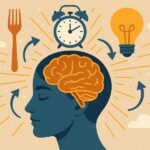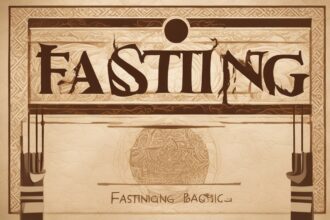Hey there, health enthusiasts! If you’ve ever wondered about the roots of fasting and how it’s evolved into a modern wellness trend, you’re in for a treat. Fasting, the practice of abstaining from food for a set period, isn’t just a fad—it’s a tradition that stretches back thousands of years across cultures and religions. Today, we’re diving deep into the history of fasting, exploring its origins, cultural significance, and the science-backed fasting benefits that have made it a cornerstone of health optimization. Whether you’re a seasoned faster or just curious about intermittent fasting advantages, this journey through time will shed light on why this practice endures. Let’s get started!
The Ancient Origins of Fasting
Fasting is as old as humanity itself. Long before we had terms like “intermittent fasting” or studies on fasting health effects, early humans likely fasted out of necessity. Hunter-gatherers didn’t have the luxury of three square meals a day; food scarcity meant periods of involuntary fasting were common. Some anthropologists suggest that this feast-and-famine cycle shaped our metabolism to thrive during times of deprivation (Mattson, 2014). But fasting wasn’t just about survival—it soon became a deliberate act tied to spiritual and cultural practices.
In ancient civilizations like Egypt, Greece, and Rome, fasting was often linked to purification and divine connection. The Egyptians fasted before important rituals to cleanse their bodies and minds, while Greek philosophers like Socrates and Plato endorsed fasting for mental clarity and self-discipline. Hippocrates, often called the father of modern medicine, famously said, “Instead of using medicine, rather, fast a day,” highlighting early recognition of fasting’s therapeutic potential (Kerndt et al., 1982). These ancient practices laid the groundwork for fasting as both a physical and spiritual tool.
Fasting in Religious Traditions
One of the most profound influences on fasting history comes from religious traditions, where it’s often a symbol of devotion, penance, or renewal. Across the globe, fasting rituals have been central to spiritual life for millennia, and they continue to shape how many people approach the practice today. The fasting benefits in these contexts often go beyond the physical, touching on emotional and communal well-being.
- Ramadan in Islam: Muslims fast from dawn to sunset during the holy month of Ramadan, abstaining from food and drink as an act of faith and self-control. This practice fosters empathy for the less fortunate and spiritual reflection.
- Yom Kippur in Judaism: Known as the Day of Atonement, this 25-hour fast is a time for repentance and spiritual cleansing among Jewish communities.
- Lent in Christianity: Many Christians observe fasting or dietary restrictions during the 40 days of Lent leading up to Easter, commemorating Jesus’ time in the wilderness.
- Buddhist and Hindu Practices: Monks and laypeople in these traditions often fast to detach from material desires and enhance meditation, focusing on mindfulness.
These traditions highlight how fasting transcends mere calorie restriction—it’s a holistic practice that nurtures the mind and spirit alongside the body. Even if you’re not religious, understanding these roots can inspire a deeper appreciation for fasting’s impact on overall wellness.
The Evolution of Fasting in Medicine
Fast forward to the Middle Ages and Renaissance, and fasting started gaining traction in medical contexts. Physicians of the time, influenced by ancient Greek and Roman ideas, prescribed fasting for various ailments, believing it could “reset” the body. By the 19th and 20th centuries, fasting began to be studied more systematically. Dr. Herbert Shelton, a pioneer in natural hygiene, promoted therapeutic fasting in the early 1900s, claiming it allowed the body to heal by conserving energy typically spent on digestion (Shelton, 1934).
Modern science has since validated some of these early observations. Research shows that fasting can trigger autophagy, a cellular cleanup process that removes damaged components and may protect against diseases like cancer and Alzheimer’s (Mattson et al., 2017). The growing interest in fasting benefits for metabolic health—such as improved insulin sensitivity and reduced inflammation—has also fueled its popularity in clinical settings (Longo & Mattson, 2014). Today, fasting isn’t just a relic of the past; it’s a cutting-edge tool in preventive medicine.
Modern Fasting: From Intermittent Fasting to Health Hacks
In the 21st century, fasting has exploded into mainstream health culture, largely thanks to the rise of intermittent fasting (IF). Unlike the prolonged fasts of ancient times, IF involves cycling between eating and fasting windows—like the popular 16:8 method, where you fast for 16 hours and eat during an 8-hour window. This approachable style has made fasting accessible to millions, with countless people reporting fasting health effects like weight loss, better focus, and increased energy.
But what’s behind these benefits? Science suggests that fasting puts the body into a state of mild stress, prompting adaptive responses that enhance resilience. For instance, fasting can lower blood sugar levels and improve lipid profiles, reducing the risk of type 2 diabetes and heart disease (Patterson et al., 2015). It also boosts the production of brain-derived neurotrophic factor (BDNF), a protein linked to cognitive health and mood regulation (Mattson, 2014). Whether you’re after physical or mental fasting advantages, there’s compelling evidence to support giving it a try.
Practical Tips for Incorporating Fasting into Your Life
Feeling inspired to explore fasting for yourself? While the history and science behind fasting benefits are fascinating, starting your own practice can feel daunting. Don’t worry—I’ve got you covered with some practical, beginner-friendly tips to ease into fasting while maximizing its health perks. Remember, it’s not about perfection; it’s about finding what works for your lifestyle.
- Start Small: If you’re new to fasting, begin with a 12:12 schedule—12 hours of fasting (including sleep) and 12 hours of eating. Gradually work up to 16:8 or other methods as you get comfortable.
- Stay Hydrated: Drink plenty of water during fasting windows to avoid dehydration, which can mimic hunger and sap your energy.
- Listen to Your Body: If you feel dizzy or overly fatigued, break your fast with a light meal. Fasting should feel sustainable, not punishing.
- Focus on Nutrient-Dense Foods: When you do eat, prioritize whole foods like vegetables, lean proteins, and healthy fats to support your body’s recovery.
- Track Your Progress: Keep a journal to note how fasting affects your energy, mood, and cravings. This can help you tweak your approach for optimal fasting wellness perks.
Before diving in, especially if you have medical conditions like diabetes or are pregnant, consult a healthcare provider. Fasting is powerful, but it’s not a one-size-fits-all solution. Tailor it to your needs, and you’ll be more likely to reap the intermittent fasting advantages that so many swear by.
Debunking Myths About Fasting
Despite its long history and proven fasting benefits, fasting still faces skepticism and misinformation. Some worry it’s a form of starvation or that it slows metabolism—myths that couldn’t be further from the truth. Let’s set the record straight with evidence-based insights. Fasting, when done correctly, doesn’t equate to deprivation; it’s a controlled, intentional practice. Studies show that short-term fasting can actually preserve muscle mass and boost metabolic rate as the body shifts to burning stored fat for fuel (Anton et al., 2018).
Another common misconception is that fasting leads to overeating later. While some may experience hunger spikes initially, research indicates that most people naturally adjust their calorie intake over time, often eating less overall (Patterson et al., 2015). By understanding the real fasting health effects, you can approach this practice with confidence, knowing it’s a sustainable tool for wellness when done mindfully.
As we’ve journeyed through the history of fasting—from ancient survival tactics to spiritual rituals and modern health hacks—it’s clear that this practice is more than a trend. It’s a time-tested tradition with profound fasting benefits for both body and mind. Whether you’re drawn to the mental clarity praised by ancient philosophers or the metabolic boosts confirmed by today’s science, fasting offers something for everyone. Start small, stay curious, and remember that this isn’t about restriction but about rediscovery. How will you incorporate fasting into your life? Drop a comment below—I’d love to hear your thoughts and experiences on unlocking the fasting wellness perks!
References
- Anton, S. D., Moehl, K., Donahoo, W. T., Marosi, K., Lee, S. A., Mainous, A. G., … & Mattson, M. P. (2018). Flipping the metabolic switch: Understanding and applying the health benefits of fasting. Obesity, 26(2), 254-268.
- Kerndt, P. R., Naughton, J. L., Driscoll, C. E., & Loxterkamp, D. A. (1982). Fasting: The history, pathophysiology and complications. Western Journal of Medicine, 137(5), 379-399.
- Longo, V. D., & Mattson, M. P. (2014). Fasting: Molecular mechanisms and clinical applications. Cell Metabolism, 19(2), 181-192.
- Mattson, M. P. (2014). Challenging oneself intermittently to improve health. Dose-Response, 12(4), 600-618.
- Mattson, M. P., Longo, V. D., & Harvie, M. (2017). Impact of intermittent fasting on health and disease processes. Ageing Research Reviews, 39, 46-58.
- Patterson, R. E., Laughlin, G. A., LaCroix, A. Z., Hartman, S. J., Natarajan, L., Senger, C. M., … & Sears, D. D. (2015). Intermittent fasting and human metabolic health. Journal of the Academy of Nutrition and Dietetics, 115(8), 1203-1212.






